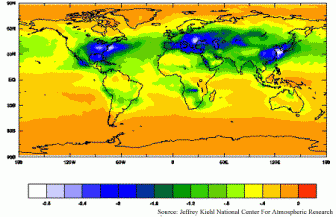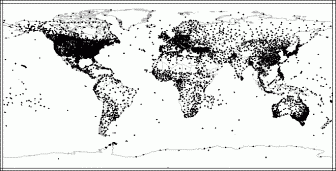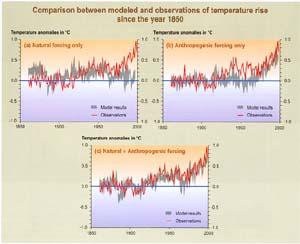This article was published by Brenda Ekwurzel in 2005, but is preserved here by demand.
Michael Crichton's book State of Fear has characters debating data (complete with graphs and footnotes) and concepts that cast doubt on the validity of global warming evidence. This doubt is echoed in the author's message at the end of the novel and in public interviews. Readers may understandably take away some misconceptions from his book. To clear up these misconceptions, we have selected some representative cases to discuss; the list below, however, is not intended to be an exhaustive list of the errors in Crichton's book.
- How was Michael Crichton able to take the same data that climate scientists use and come to the conclusion that global warming isn't a real threat?
- State of Fear uses graphs that don't show a warming trend. How can specific locations show cooling if global warming is happening?
- What is the "urban heat island effect" and is it contributing to warming?
- Crichton argues that C02 in the atmosphere is not closely correlated with warming trends. So why is C02 blamed as a greenhouse gas?
- Several times Crichton notes that glaciers are expanding not retreating. Is this accurate or only part of the story?
- Michael Crichton says we can't predict the future. Does this preclude our taking steps to reduce heat trapping gas emissions?
- Why do we have to act now to reduce our dependence on fossil fuels?
1. How was Crichton able to take the same data that climate scientists use and come to the conclusion that global warming isn't a real threat?
Anyone can delve into the climate literature and come to a deeper understanding of global climate change evidence. Yet the literature examples Crichton picked, and the way they are presented, seem to make a case against global warming. Scientists with climate expertise have considered not just the narrow sampling of the scientific literature that Crichton cites but many hundreds of additional papers in order to understand the full complexity of the climate system.
Climate scientists agree on the most basic key points while they continue to refine such questions as the magnitude and rate of climate change. The National Academy of Sciences, The American Geophysical Union, The American Meteorological Society, and the Intergovernmental Panel on Climate Change (IPCC) have all issued statements affirming that climate change is underway, the impacts are significant, and humans have influenced recent climate changes. Although Crichton likes to claim that consensus is not relevant in science, we disagree. When scientists with climate-relevant expertise evaluate the data and the majority comes to the same basic conclusion, this is an important result.
2. State of Fear uses many graphs that don't show a warming trend. How can specific locations show cooling if global warming is happening?
Twenty of thirty-three graphs shown in the novel for various localities do not demonstrate a warming trend. The characters raise common sense reactions to these graphs. One character illustrates how one location (West Point, NY) can show a warming, cooling, or no trend depending on how many years are shown on the graph.
Increases in carbon dioxide (CO2) create an overall warming tendency in the atmosphere. Shifts in clouds, water vapor, and the great currents in the ocean and air, however, cause complex responses in which some regions warm more than the average while others warm less than average, or even cool. Finding a cooling trend in some region (including the Antarctic interior, which Crichton makes much of) is therefore fully compatible with the physics on which climate models are based.
Furthermore, other human-induced changes on the atmosphere can lead to regional cooling. For example, temperatures in the latter half of the last century generally cooled in the East while warming in the western United States, according to the Environmental Protection Agency. This pattern of warming and cooling in the U.S. may be part of a worldwide pattern: while most of the earth has warmed, the regions that are downwind from major sources of air pollution (specifically sulfur dioxide emissions) have generally cooled (Figure 1). Sulfur dioxide emissions convert into sulfate aerosols in the atmosphere. The ability of sulfate aerosols to reflect the sun's radiation may be one reason that increasing heat-trapping gases have not warmed the earth as much as some climate models project.

In general, climate trends are often difficult to detect in data from individual stations because each station is subject to local effects. These variations can be reduced by averaging together the data from many stations, which is why climate scientists rely on such averages in detecting the first signs of the effect of CO2 increases on temperature. So far, the initial effect is still relatively small for two reasons: (i) part of that effect has been canceled temporarily by increases in sulfate aerosol, and (ii) the warming has been delayed because it takes a long time for the vast mass of the ocean to heat up.
3. What is the "urban heat island effect" and is it contributing to warming?
State of Fear characters suggest that the "urban heat island effect" may be responsible not only for heating in cities but also for global warming. They note that many long-term temperature stations are now surrounded by larger cities and could contribute to the warming seen in urban stations. While amplified warming does occur in cities and is an important local phenomenon, cities occupy only a small fraction of the planet compared to the vast area of oceans, ice caps, uninhabited mountains, and rural landscapes. Scientists are well aware and take measures to adjust for this effect so that the overall temperature trend is not biased. Temperature monitoring stations exist around the globe, on both land and sea, and we see a clear warming trend from many locations. Compared to the number of temperature stations for the U.S., it is clear that urban stations are a minor component of the U.S. temperature station network (Figure 2). The IPCC (2001) stated that urban heat island effects could contribute no more than six percent of the rising average temperature trends in 1990, and a National Academy study of the surface temperature record concluded that the global surface temperature trend accurately reflects warming.
Furthermore, temperature gauges are not the only way to measure temperature changes. Satellites operating since 1979 have monitored lower atmosphere (tropopause) temperature over the land and oceans. Although early satellite analyses indicated only a small amount of warming during this period, these early results overlooked a satellite sensor feature that we now know included cooling data from higher in the atmosphere. Corrected for this error, the satellite measurements are now in good agreement with the global average surface temperature trends.

4. Crichton argues that CO2 in the atmosphere is not closely correlated with warming trends. So why is CO2 blamed as a greenhouse gas?
Over a century ago, scientists researching CO2 discovered that the earth's temperature is very sensitive to small changes in atmospheric CO2. Crichton's novel includes a graph showing the relationship between global average temperatures and atmospheric CO2 levels between 1880 and 2003. This graph shows a broad correlation between temperature and CO2, although some time periods do not match up. A character in the novel asks, "So, if rising carbon dioxide is the cause of rising temperatures, why didn't it cause temperatures to rise from 1940 to 1970?"
The answer is that CO2 is only one of several factors that influence temperature, such as volcanic eruptions, solar variability, sulfur dioxide emissions (see Figure 1), and small changes in the earth's orbit. The combined impact of all effects was cooling for those middle decades of the 20th century. When climate scientists look at the entire last century, however, they are unable to explain the significant temperature increases solely from natural causes. Only when the trends for human-induced heat-trapping gases, sulfur dioxide emissions, soot, ozone, and land use changes are also included do the hindcast model results (Figure 3) and the recorded reality match up. This is particularly true of the pronounced warming that has occurred since 1970.

5. Several times Crichton notes that glaciers are expanding not retreating. Is this accurate or only part of the story?
Mr. Crichton picks evidence that supports his position and then sprinkles this data throughout the novel. He discusses the advance of many glaciers in Iceland and Norway, for example, while the evidence for accelerated melting of the major Greenland ice sheet is ignored. The rapid melting of the Kilimanjaro glacier is mentioned only to be dismissed. Crichton doesn't let the reader know, however, that this ice sheet has survived the past 11,000 years, including a 300 year long African mega-drought. At present rates of melting, Mt. Kilimanjaro glacier is likely to be gone before 2020. Most other tropical glaciers studied are also undergoing unprecedented retreat, and big changes are also underway in Antarctica. The Larsen B ice shelf, for example, broke up in 2002 in response to coastal warming, after having survived for more than 12,000 years. The precise mechanism responsible for these massive events is a matter of lively inquiry in the scientific literature, but the fact that they are all happening now that human activities have increased the atmospheric carbon dioxide concentration to a level not seen over the past 400,000 years, after having survived millennia, is powerful circumstantial evidence that should not be lightly dismissed.
6. Michael Crichton says we can't predict the future. Does this preclude our taking steps to reduce heat trapping gas emissions?
By way of analogy, the occurrence of large earthquakes is also very difficult to predict. Just because we can't predict when the next big earthquake in California will occur, should we stop building earthquake-resistant buildings? The IPCC projects that global temperatures will increase anywhere from +2.5°F to +10.4°F (+1.4°C to +5.8°C) by century's end. Scientists show a range of temperature changes, rather than a single number, for a couple of different reasons: (i) imperfect knowledge about certain climate processes, such as cloud feedbacks and (ii) different assumptions about how much CO2 and other pollutants people will put into the atmosphere. These different hypotheses regarding the spread of temperature due to reason (i) are not just "guesses" as Crichton claims, but are constrained by fundamental physical principles and are tested against a challenging array of test cases drawn from the present and past climate of the Earth. The temperature spread attributed to reason (ii) arises from suppositions regarding factors such as population growth, fossil-fuel emissions, and economic and technological developments. The results provide a range of possible outcomes for policy makers to evaluate. For example, decision makers already have a good idea what will happen if no action to reduce CO2 emissions is taken: the "business as usual" scenario shows significant increases in temperature and changes in precipitation, leading to serious impacts over the next century.
Since a large portion of the projected range in temperature increases are based on human actions, the good news is that the future is in our hands. We have the opportunity right now to make choices for the future that will avoid the worst climate change impacts from occurring.
7. Why do we have to act now to reduce our dependence on fossil fuels?
Global warming from CO2 build-up in the atmosphere is different from other pollution problems society has faced. The CO2 emissions we release today very literally will determine the climate we leave to our children and future generations. This is because CO2 is very long-lived in the atmosphere. You may have heard that each CO2 molecule that we emit from burning fossil fuels in our cars and power plants will remain in the atmosphere between 50 to 200 years. The more complex explanation is even more sobering — carbon cycle models indicate that ~25 percent of CO2 from fossil fuel combustion will remain in the atmosphere for thousands of years, and ~7 percent longer than one hundred thousand years.
Atmospheric CO2 concentrations are already at unprecedented levels and the consequences of a changing climate are already underway. If we wish to prevent the most severe climate change projections from actually happening, we must reverse the heat-trapping emissions trend as quickly as possible. The progressive accumulation of atmospheric CO2, however, becomes more difficult and costly to reverse as time goes on.
Current solutions exist that can be implemented now—we don't need to wait or to rely on unknown future technological developments. Many large corporations have already reported substantial savings after they instituted measures to reduce heat-trapping gas (greenhouse gas) emissions. Recently, DuPont reported $2 billion and IBM $791 million in savings from reducing greenhouse gas emissions. We can harness new technology as it develops, but there is no reason to delay implementation of currently available technologies, such as producing electricity with wind and solar power, improving building energy efficiency, and getting better gas mileage in our vehicles.
References:
Archer, D., H. Kheshgi, and E. Maier-Reimer, Dynamics of fossil fuel CO2 neutralization by marine CaCO3, Global Biogeochemal Cycles, 12, 259-276, 1998.
Archer, D., H. Kheshgi, and E. Maier-Riemer, Multiple timescales for neutralization of fossil fuel CO2, Geophysical Research Letters, 24, 405-408, 1997.
EPA (2002), Inventory of U.S. Greenhouse Gas Emissions and Sinks: 1990 -2000, U.S. Environmental Protection Agency, Office of Atmospheric Programs, EPA 430-R-02-003, http://epa.gov/climatechange/emissions/usinventoryreport.html
EPA (2000) http://yosemite.epa.gov/oar/globalwarming.nsf/content/ ClimateTrendsTemperature.html
Epstein, P.R. and J.J. McCarthy, (2004). Assessing Climate Stability, Bulletin of the American Meteorological Society, 85, 1863-1870.
Fu, Q., C.M. Johanson, S.G. Warren, and D.J. Seidel (2004a) Contribution of stratospheric cooling to satellite-inferred tropospheric temperature trends, Nature 429, 55-58.
IPCC (2001), Climate Change 2001: Intergovernmental Panel on Climate Change Third Assessment Report.
Low-carbon leaders: Profiting from emission reductions, Environmental Finance, December 2004 – January 2005 issue, Fulton Publishing, London.
NAS panel (2000): Reconciling observations of global temperature change.
National Academy Press.
Oreskes, N. (2004) The Scientific Consensus on Climate Change, Science, 306, 1686
Schiermeier, Q (2004) A rising tide. Nature 428, 114-115.
Thompson L.G., E. Mosley-Thompson, M.E. Davis, K. A. Henderson, H. H. Brecher, V.S. Zagorodnov, T. A. Mashiotta, P-N. Lin, V.N. Mikhalenko, D. R. Hardy, and J. Beer (2002) Kilimanjaro ice core records: Evidence of Holocene climate change in tropical Africa, Science 298, 589-593.
Zwally, H.J., W. Abdalati, T. Herring, K. Larson, J. Saba, and K. Steffen, (2002). Surface melt-induced acceleration of Greenland ice-sheet flow. Science, 297, 218-222.
Additional resources:
http://www.brookings.edu/views/op-ed/fellows/sandalow20050128.htm (Michael Crichton and Global Warming by David Sandalow, The Brookings Institution)
http://www.realclimate.org/index.php?p=74 (RealClimate.org posting December 13, 2004: Michael Crichton's State of Confusion)



